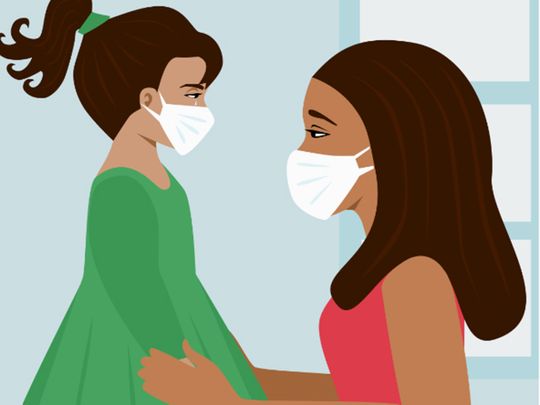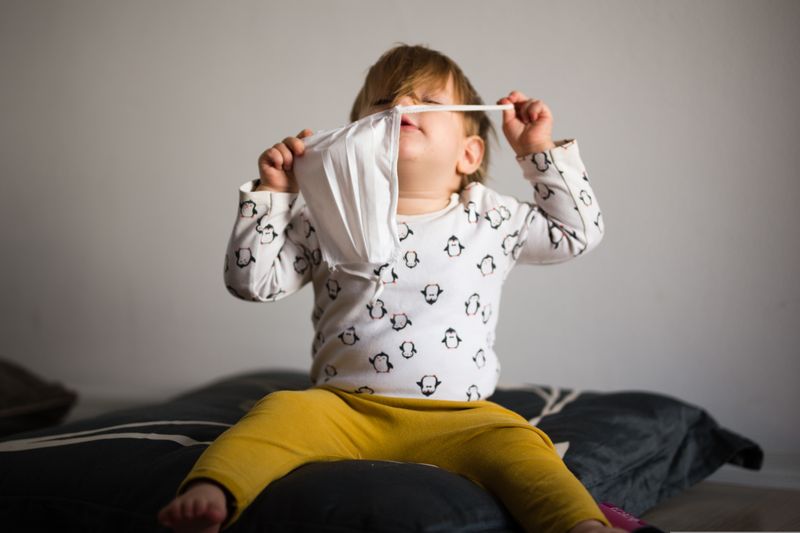
Every time my 16-month-old daughter gets near my head when I’m wearing a face mask, she tries to tear it off. Sometimes it’s playful and turns into a game of Peekaboo, other times it degenerates into a bad-tempered battle of wills and screechy toddler frustration. Either way, she tends to win.
Because, from her 16-month-old point of view, by concealing my face I am taking away one of the major ways in which we communicate. No wonder she seems so cross about it - it’s hard enough for adults to understand each other effectively when everyone’s mouths are covered up, but for a child who relies entirely on non-verbal cues for communication, wearing a face mask means I am effectively blanking her. Literally, in fact.
And for scientists who study how children’s language and communication develops, a masked society like the one we are living in during the pandemic raises some interesting questions and challenges for caregivers to overcome.
How face masks could impact younger kids
Although children under the age of 6 years are not required to wear face masks in the UAE, they may still be affected by the fact that everyone around them is wearing masks. “The most prominent psychological implications of mask-wearing for children include the loss of non-verbal skills and difficulties in the understanding of body language in others,” says UAE-based educational psychologist, Dr Diksha Laungani.
“The emphasis is now on the adult carer’s eyes, tone of voice, their gestures and posture more than ever. At a time when emotional understanding and resilience matter the most, these are impaired to a certain extent by mask-wearing.”
Although everyone agrees that face masks are crucial for curbing the spread of COVID-19 and must be worn, scientists such as Lisa S Scott, a professor in Psychology at the University of Florida who studies visual learning, are concerned that adult mask-wearing could negatively impact younger children in several key ways.
Firstly, they may have difficulty recognising people in masks (something most adults can understand too!) because of the way they process faces.”Our work shows that infants pay close attention to eyes and mouths on faces,” Dr Scott told The Conversation. “Infants also learn that two eyes are usually above a nose which is above a mouth, and they learn to combine these features into one whole. Babies use faces as a tool for learning from familiar people, like mum, dad or a care worker.”
This could potentially be disorientating for kids, agrees UAE-based educational psychologist Dr Laungani. “Children between the ages of 2-6 years largely connect with the world around them using visual representations (symbols) and have not developed a sense of cause and effect,” she says. “The mask seemingly hides the known (people) for our little ones.”
Social referencing
Children also learn a great deal about emotions from adult faces. Young children rely on their caregiver’s facial expressions and tone of voice to regulate their responses toward people and new situations. Psychologists call this form of emotional communication, which happens between infancy and the early pre-school years, social referencing.
There are many studies that show how children from as young as six months old rely on the changes in adult caregivers’ faces in order to gauge the safety of a situation, to determine what counts as humorous and worthy of giggling at, and to learn language. With much of the face obscured by masks, it’s possible children may have difficulty with emotional recognition and social interaction.
Language development
And finally, babies and young children zero in on mouths to learn language, says Dr Scott. “Young babies shift their visual focus from looking primarily at the eyes of talking faces to looking at the mouths between 4 and 8 months of age. Infants begin to understand the meaning of familiar words between 6 and 9 months of age. Looking toward the mouth increases as infant speaking skills increase. Although this focus on the mouth decreases around 9 to 12 months of age, it increases again around 14 months of age during word learning. Even 5-year-olds show increased interest in the mouths of talking faces compared to adults.”
While it is unknown how covering the mouth will directly affect development at every age, Scott says these studies suggest that infants and children use the mouths of faces as a tool for learning to produce speech sounds and for learning new words. “Wearing masks around infants and children during the first five years of life may reduce their ability to learn from auditory and visual cues – and this may negatively influence speech and language learning,” says Scott.
David Lewkowicz, a scientist at the Yale Child Study Center who has studied lip reading in babies, agrees that visual cues are almost as important as auditory cues for young children’s language development. “Masks are not a great thing for communication in young kids” he told The New York Times.

Children with additional needs
For children with additional needs such as autism or sensory processing disorders, mask-wearing is likely to have the biggest impact of all, says Dr Langauni. “It has certainly been a complex time for children with additional needs, their families and educators,” she says. “In my practice, I usually turn to a few core principles when working with children with additional needs. Some of these include: communication, relationships and consistency - all of which have gone for a toss with the wearing of masks! For instance, not being able to recognise their carer at school in a mask, or being unable to go near their peers even with a mask on are just some of the adaptations which children have had to make in these past few months. While all children have faced these changes, those who thrive on familiarity and routine have felt its impact a bit more than others, especially in terms of learning and regulating emotions and behaviour. Most of their attention has been focused on coping with the changes, rather than catching-up with learning.”
In recognition of this increased challenge the Knowledge and Human Development Authority guidelines have given schools in Dubai the flexibility to support students with additional needs by exempting them from mask wearing, when proper documentation has been provided. Yvonne Donoghue, Head of Inclusion at Horizon English School, acknowledges that these students already experience significant barriers to learning and that the addition of a mask could have longer lasting implications, especially when they don’t understand the reasons behind it. “We have used social stories, as part of the Wellbeing sessions, to explain COVID and all the ways that we can keep each other and ourselves safe, in an effort to diminish possible implications,” says Donoghue.
Dr Langauni adds: “What has helped for children with additional needs is transition (preparedness), in the form of tools such as social stories, role-play, creativity and innovation, mixed with the attributes of patience and persistence. In addition, the wearing of clear masks has greatly aided carers in mitigating many concerns associated with face/emotion recognition.”
How mask-wearing affects older kids
But there have also been some unexpected benefits to mask-wearing for some age groups, says Dr Langauni. "As with all age groups, I think teenagers, too, experienced some teething issues with mask-wearing during the initial months.
“But, while teenagers are known to be a ‘risk-taking’ and vulnerable population, who are heavily influenced by their peer groups, the teens that I know and have worked with have shown an incredible understanding of the functions and boundaries of mask-wearing, adapting to their version of the new normal quite well.
“An interesting point to note is that some self-conscious teens expressed a sense of relief at wearing masks which ‘hid their faces’. This anecdotal evidence resonates with the tendency to explore and form a sense of identity during the teenage years, which may be influenced by mask-wearing. It will certainly be interesting to explore how teenagers feel and behave once the need for wearing masks will (hopefully) cease in the coming future.”
How can parents mitigate the impact of mask-wearing
While it is possible that face masks could impede children’s development in some ways, there are many ways in which these challenges can be overcome. “My advice to caregivers at school and home is to be more clear and specific in their language so that children clearly understand expectations, tasks, boundaries and expressions,” says Dr Laungani. “Spend more time talking about feelings and emotions in class or at home, use emotion cards frequently and name and label emotions while talking to promote emotional growth in children.”
Asma Ahmed, counsellor and wellbeing lead at Dubai-based British primary school Horizon English School, says: “Communicating with your child in an open and honest way will help to avoid long-term effects, as well as asking deeper questions. Rather than ‘How was your day?’ try delving into ‘What type of feelings are you having most of the time?’ ‘What are you feeling right now?’ and ‘Tell me what kind of thoughts are you having?’. This will allow you as caregiver to gain greater insight into how your child is feeling.”
Finding creative ways to convey emotion with body language rather than just facial expression can also help, adds Ahmed: “Our morning greetings now include Air high fives’ ‘Thumbs up and thumbs down’ and zones of regulation check-ins. This is a simple, yet effective way for the students to let their teacher know how they are feeling, whilst not been restricted to just facial expression.”
Ahmed adds that Horizon English School teachers have been playing games such as ‘Guess my expression’ asking children to watch the teacher's eyes and eyebrows as they try to make them as expressive as their mouth. Children are then asked to guess how the teacher or their classmates are feeling from the expression of their eyes and eyebrows. “Incorporating these ‘smiling eyes’ expression games into the children’s daily school routine has proven to have a positive impact on their mental wellbeing and readjustment into the new normal,” she says.
Perhaps the simplest and most effective way of reducing the impact of face masks on the emotional and linguistic development of babies and young children is for adults to wear transparent face masks, which evaporates most of the problems altogether, says the University of Florida's Dr Scott. Although transparent face masks do not seem to be the norm in the UAE at the moment, if your young child or baby spends a great deal of time around masked caregivers in a daycare or school environment and you are worried about it, it may be worth requesting this.
A lot of the impact of mask-wearing on children will also come from the way their caregivers present it, says educational psychologist Dr Languani. “To ease the motivation and compliance of children for mask-wearing, we need to reframe masks in a positive light,” she says. “Check if your child associates masks with a sense of fear or protection. Empower them to feel like superheroes and key members of the society in our fight against the pandemic.
“Do not panic if your child is struggling with mask-wearing. This is a temporary phase and recognise that this struggle is building their resilience. Our response to their difficulties is what matters and the coping strategies which children will learn now will last for a lifetime.”
• Introduce the facemask to children in a familiar place, such as your home, before bringing them into the world of covered faces. Trying new things within the comfort of your home and safety of your family offers children the opportunity to step outside their normal routines.
• Let your child see the mask and then put it on your face. Explain to your child that you will be wearing the mask when you’re out and about, and that other people will be wearing them too. Helping your child to anticipate future events offers security and eases anxiety.
• Play peek-a-boo: Cover your mouth and then take the mask away to reveal a smile. Do this several times. Explain to your child that you’ll be smiling even though your face isn’t visible.
• Talk to your child through your mask. The mask will muffle your voice, so it’s helpful to find a speaking volume that your child can hear."









